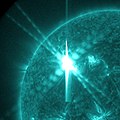
Original file (2,104 × 2,108 pixels, file size: 1.2 MB, MIME type: image/jpeg)
| This is a file from the Wikimedia Commons. Information from its description page there is shown below. Commons is a freely licensed media file repository. You can help. |
Summary
| DescriptionX Class Solar Flare Sends ‘Shockwaves’ on The Sun (6819094556).jpg |
NASA image captured March 6, 2012 To view a video of this event go to: www.flickr.com/photos/gsfc/6815861366 The sun erupted with one of the largest solar flares of this solar cycle on March 6, 2012 at 7PM ET. This flare was categorized as an X5.4, making it the second largest flare -- after an X6.9 on August 9, 2011 -- since the sun’s activity segued into a period of relatively low activity called solar minimum in early 2007. The current increase in the number of X-class flares is part of the sun’s normal 11-year solar cycle, during which activity on the sun ramps up to solar maximum, which is expected to peak in late 2013. About an hour later, at 8:14 PM ET, March 6, the same region let loose an X1.3 class flare. An X1 is 5 times smaller than an X5 flare. These X-class flares erupted from an active region named AR 1429 that rotated into view on March 2. Prior to this, the region had already produced numerous M-class and one X-class flare. The region continues to rotate across the front of the sun, so the March 6 flare was more Earthward facing than the previous ones. It triggered a temporary radio blackout on the sunlit side of Earth that interfered with radio navigation and short wave radio. In association with these flares, the sun also expelled two significant coronal mass ejections (CMEs), which are travelling faster than 600 miles a second and may arrive at Earth in the next few days. In the meantime, the CME associated with the X-class flare from March 4 has dumped solar particles and magnetic fields into Earth’s atmosphere and distorted Earth's magnetic fields, causing a moderate geomagnetic storm, rated a G2 on a scale from G1 to G5. Such storms happen when the magnetic fields around Earth rapidly change strength and shape. A moderate storm usually causes aurora and may interfere with high frequency radio transmission near the poles. This storm is already dwindling, but the Earth may experience another enhancement if the most recent CMEs are directed toward and impact Earth. In addition, last night’s flares have sent solar particles into Earth’s atmosphere, producing a moderate solar energetic particle event, also called a solar radiation storm. These particles have been detected by NASA’s SOHO and STEREO spacecraft, and NOAA’s GOES spacecraft. At the time of writing, this storm is rated an S3 on a scale that goes up to S5. Such storms can interfere with high frequency radio communication. Besides the August 2011 X-class flare, the last time the sun sent out flares of this magnitude was in 2006. There was an X6.5 on December 6, 2006 and an X9.0 on December 5, 2006. Like the most recent events, those two flares erupted from the same region on the sun, which is a common occurrence. Credit: NASA/SDO/AIA NASA Goddard Space Flight Center enables NASA’s mission through four scientific endeavors: Earth Science, Heliophysics, Solar System Exploration, and Astrophysics. Goddard plays a leading role in NASA’s accomplishments by contributing compelling scientific knowledge to advance the Agency’s mission. Follow us on Twitter Like us on Facebook Find us on Instagram |
| Date | |
| Source | X Class Solar Flare Sends ‘Shockwaves’ on The Sun |
| Author | NASA Goddard Space Flight Center from Greenbelt, MD, USA |
Licensing
- You are free:
- to share – to copy, distribute and transmit the work
- to remix – to adapt the work
- Under the following conditions:
- attribution – You must give appropriate credit, provide a link to the license, and indicate if changes were made. You may do so in any reasonable manner, but not in any way that suggests the licensor endorses you or your use.
| This image was originally posted to Flickr by NASA Goddard Photo and Video at https://flickr.com/photos/24662369@N07/6819094556. It was reviewed on 17 September 2016 by FlickreviewR and was confirmed to be licensed under the terms of the cc-by-2.0. |
17 September 2016
| Public domainPublic domainfalsefalse |
| This file is in the public domain in the United States because it was solely created by NASA. NASA copyright policy states that "NASA material is not protected by copyright unless noted". (See Template:PD-USGov, NASA copyright policy page or JPL Image Use Policy.) |  | |
 |
Warnings:
|
Captions
Items portrayed in this file
depicts
some value
7 March 2012
image/jpeg
File history
Click on a date/time to view the file as it appeared at that time.
| Date/Time | Thumbnail | Dimensions | User | Comment | |
|---|---|---|---|---|---|
| current | 21:48, 17 September 2016 |  | 2,104 × 2,108 (1.2 MB) | Vanished Account Byeznhpyxeuztibuo | Transferred from Flickr via Flickr2Commons |
File usage
Global file usage
The following other wikis use this file:
- Usage on bn.wikipedia.org
- Usage on et.wikipedia.org
Metadata
This file contains additional information, probably added from the digital camera or scanner used to create or digitize it.
If the file has been modified from its original state, some details may not fully reflect the modified file.
| Image title |
|
|---|---|
| Headline | X Class Solar Flare Sends ‘Shockwaves’ on The Sun |
| Pixel composition | Palette |
| Orientation | Normal |
| Horizontal resolution | 100 dpi |
| Vertical resolution | 100 dpi |
| Software used | IDL 7.0, ITT Visual Information Solutions |
| File change date and time | 09:27, 7 March 2012 |
| Urgency | High (2) |
| IIM version | 4 |